A wall facing an empty grass plot along 19th Street and Blue Island Avenue in the Pilsen neighborhood, once riddled with unwanted graffiti, now has a newly completed mural painted by Mexican artist Raul Sisniega.
The mural, completed on April 30, shows Aztec imagery spelling out the word “semilla,” meaning seeds in Spanish. During the mural’s progression young community members could be seen volunteering their time painting the mural’s background. Sisniega and volunteers often were seen stepping back to see the progress occasionally.
The new mural, which was painted on the wall for a small dental care center, was organized with help from the Pilsen Art’s and Community House (PACH). “He wanted the opportunity to do a mural,” said Teresa Magaña, a Chicago resident and the executive director of PACH. “We told him, ‘well, any mural projects that we do have to involve the community,’ . . . We’ve intentionally made that point to make sure we’re checking off all those boxes.”
People have used Chicago’s neighborhoods as a canvas, making artwork across the city for decades; many of these public works today fall in line with the modern street art scene and mural movement on Chicago’s South and West sides. But the discussion around the newer murals being made specifically in Pilsen, have been divisive.
Today, community members and other local older artists have been critical of modern murals done by individuals in the street art scene, arguing that the public artwork does not reflect the community.
“The older murals in Pilsen … they’re still speaking on the struggle that people of color are still enduring,” said Magaña. “Using public art as a platform to get yourself known and your artwork known . . . I can respect it in that sense, but I do believe that if they [street artists] don’t have mentorship or influence from … older artists with experience, then they’re naive to the concept … what is your art going to speak on five years from now? Ten years from now?”
Pilsen has become a predominantly Mexican-American, immigrant-based, working-class neighborhood throughout the ‘60s and ‘70s and within its development, it has created an early identity through the artwork and murals.
Murals include La Esperanza, completed in 1979, located outside of Benito Juarez Community Academy, and Prevent World War III, done in the early 1980s located on 18th Street and Western Avenue by well-known Chicago artist Marcos Raya. Many of Raya’s murals in Pilsen were made around the 1980s.
“You walk into Pilsen, and for some people, they find it very romantic—I don’t,” said Raya regarding the contemporary Pilsen murals. “When you walk in and you see ‘La Virgen De Guadalupe’ [The Virgin Mary] everywhere, when you see ‘paleteros’ [ice cream vendors] everywhere, there is this culture of this Mexican proletariat and we can’t get away from that.”
Raya has been extremely critical of murals that display stereotypical themes and imagery associated with Mexican culture, writing it off under a term he likes to call “Taco Art.”
“Some of the guys that are doing murals are because there is money involved like never before. There was no money for murals because the murals were truly for the community. These ones are like, more like to decorate,” said Raya. His perspective regarding what murals should reflect in the Pilsen neighborhood follows his formula that, “any Mexican artist, who wants to go Chicano but without the politics, is Taco Art . . . they need the Chicano Movement.”
Originally from Guanajuato, Mexico, Raya moved to Chicago at the age of fifteen in 1964 and resided in Pilsen. Influenced by his personal struggle, you will find that Raya has rooted that experience within his artwork like Mexican revolutionary artists Diego Rivera and José Clemente Orozco.
Being a major part of the Mexican mural renaissance in Pilsen in the 1970s, the intention of his murals are to create a public dialogue on political and social issues within the neighborhood and citywide. He believes “Taco Art” is not good for the neighborhood; it does not strike a discussion in his view.
But not all artists have this opinion on the role of murals.
Outside of El Popocatepetl Tortilleria, a tortilla producer in Pilsen, a mural facing South Wolcott Street and 21st Street depicts Cuauhtémoc, the last Aztec ruler in the year 1521. Another wall on the business is dedicated to the grandfather and founder of the business who had passed away.
Painted in the summer of 2019 by a married couple, who go by the alias of Matr & Kozmo, the proposed mural was met with resistance by some community members. “We were getting a lot of hate,” said Kozmo, a Little Village artist and muralist. “We were trying to do something for a family that just lost their dad . . . they get to decide what they want on their building and yet somehow we’re gentrifiers for doing something we were hired to do by the family?”
At the beginning of the mural’s development, Kozmo said she was in shock by the amount of hate in the form of verbal altercations they received. Members of the community accused the artists of being “gentrifiers,” regardless of the mural being commissioned by the family who owns the business and the mural being painted by local Latinx artists.
As a full-time artist, Kozmo’s main frustration comes from people calling artists in the street art scene “gentrifiers” for going outside of their respective neighborhoods to create murals especially if artists get paid for their work.
Since moving to Back of the Yards with her husband Matr, and her children, Kozmo has been in the street art scene for the last four years painting murals around the city, with an untitled piece located at El Popocatepetl, as well as with her street art character cartoonist-styled burger flower. Matr, who began mentoring Kozmo, now works beside her in painting murals.
Her character stems from two memories she holds from both her parents and as a representation of her love for nature.
“I know that the neighborhood is ever-changing,” said Magaña, “It’s still primarily Latino so I think for the younger generation artwork like that reflecting their culture is gonna keep them curious … because if you don’t see some kind of cultural imagery … do we really know who we are?”


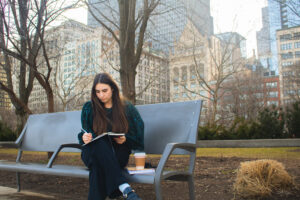

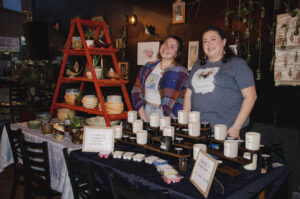
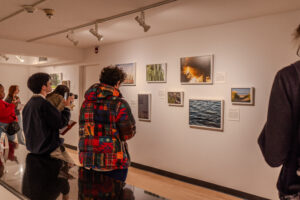


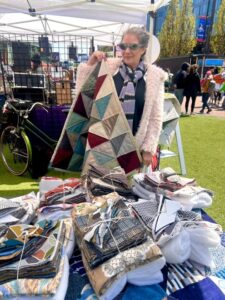
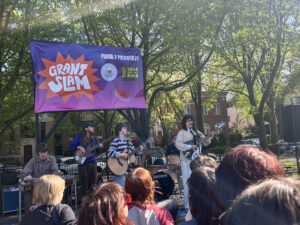

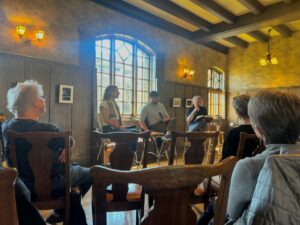

Be First to Comment